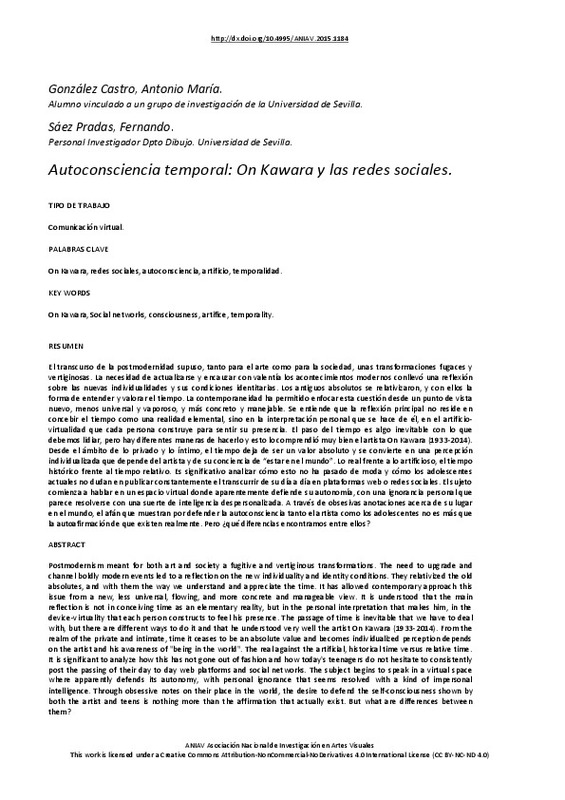JavaScript is disabled for your browser. Some features of this site may not work without it.
Buscar en RiuNet
Listar
Mi cuenta
Estadísticas
Ayuda RiuNet
Admin. UPV
Autoconsciencia temporal: On Kawara y las redes sociales
Mostrar el registro sencillo del ítem
Ficheros en el ítem
| dc.contributor.author | González Castro, Antonio
|
es_ES |
| dc.contributor.author | Sáez Pradas, Fernando
|
es_ES |
| dc.date.accessioned | 2017-10-02T12:19:07Z | |
| dc.date.available | 2017-10-02T12:19:07Z | |
| dc.date.issued | 2015-11-26 | |
| dc.identifier.isbn | 9788490483411 | |
| dc.identifier.uri | http://hdl.handle.net/10251/88444 | |
| dc.description.abstract | [EN] Postmodernism meant for both art and society a fugitive and vertiginous transformations. The need to upgrade and channel boldly modern events led to a reflection on the new individuality and identity conditions. They relativized the old absolutes, and with them the way we understand and appreciate the time. It has allowed contemporary approach this issue from a new, less universal, flowing, and more concrete and manageable view. It is understood that the main reflection is not in conceiving time as an elementary reality, but in the personal interpretation that makes him, in the device-virtuality that each person constructs to feel his presence. The passage of time is inevitable that we have to deal with, but there are different ways to do it and that he understood very well the artist On Kawara (1933H2014). From the realm of the private and intimate, time it ceases to be an absolute value and becomes individualized perception depends on the artist and his awareness of "being in the world". The real against the artificial, historical time versus relative time. It is significant to analyze how this has not gone out of fashion and how today's teenagers do not hesitate to consistently post the passing of their day to day web platforms and social networks. The subject begins to speak in a virtual space where apparently defends its autonomy, with personal ignorance that seems resolved with a kind of impersonal intelligence. Through obsessive notes on their place in the world, the desire to defend the self-consciousness shown by both the artist and teens is nothing more than the affirmation that actually exist. But what are differences between them? | es_ES |
| dc.description.abstract | [ES] El transcurso de la postmodernidad supuso, tanto para el arte como para la sociedad, unas transformaciones fugaces y vertiginosas. La necesidad de actualizarse y encauzar con valentía los acontecimientos modernos conllevó una reflexión sobre las nuevas individualidades y sus condiciones identitarias. Los antiguos absolutos se relativizaron, y con ellos la forma de entender y valorar el tiempo. La contemporaneidad ha permitido enfocar esta cuestión desde un punto de vista nuevo, menos universal y vaporoso, y más concreto y manejable. Se entiende que la reflexión principal no reside en concebir el tiempo como una realidad elemental, sino en la interpretación personal que se hace de él, en el artificio-virtualidad que cada persona construye para sentir su presencia. El paso del tiempo es algo inevitable con lo que debemos lidiar, pero hay diferentes maneras de hacerlo y esto lo comprendió muy bien el artista On Kawara (1933-2014). Desde el ámbito de lo privado y lo íntimo, el tiempo deja de ser un valor absoluto y se convierte en una percepción individualizada que depende del artista y de su conciencia de “estar en el mundo”. Lo real frente a lo artificioso, el tiempo histórico frente al tiempo relativo. Es significativo analizar cómo esto no ha pasado de moda y cómo los adolescentes actuales no dudan en publicar constantemente el transcurrir de su día a día en plataformas web o redes sociales. El sujeto comienza a hablar en un espacio virtual donde aparentemente defiende su autonomía, con una ignorancia personal que parece resolverse con una suerte de inteligencia despersonalizada. A través de obsesivas anotaciones acerca de su lugar en el mundo, el afán que muestran por defender la autoconsciencia tanto el artista como los adolescentes no es más que la autoafirmación de que existen realmente. Pero ¿qué diferencias encontramos entre ellos? | es_ES |
| dc.format.extent | 6 | es_ES |
| dc.language | Español | es_ES |
| dc.publisher | Editorial Universitat Politècnica de València | es_ES |
| dc.relation.ispartof | II CONGRESO INTERNACIONAL DE INVESTIGACIÓN EN ARTE VISUALES | es_ES |
| dc.rights | Reconocimiento - No comercial - Sin obra derivada (by-nc-nd) | es_ES |
| dc.subject | Arte | es_ES |
| dc.subject | Producción artística | es_ES |
| dc.subject | Estética | es_ES |
| dc.subject | Teoría del Arte | es_ES |
| dc.subject | Gestión cultural | es_ES |
| dc.subject | Educación artística | es_ES |
| dc.subject | Investigación artística | es_ES |
| dc.title | Autoconsciencia temporal: On Kawara y las redes sociales | es_ES |
| dc.type | Capítulo de libro | es_ES |
| dc.type | Comunicación en congreso | es_ES |
| dc.identifier.doi | 10.4995/ANIAV2015.1184 | |
| dc.rights.accessRights | Abierto | es_ES |
| dc.description.bibliographicCitation | González Castro, A.; Sáez Pradas, F. (2015). Autoconsciencia temporal: On Kawara y las redes sociales. En II CONGRESO INTERNACIONAL DE INVESTIGACIÓN EN ARTE VISUALES. Editorial Universitat Politècnica de València. 857-862. https://doi.org/10.4995/ANIAV2015.1184 | es_ES |
| dc.description.accrualMethod | OCS | es_ES |
| dc.relation.conferencename | II Congreso Internacional de Investigación en Artes Visuales. |< real | virtual >| ANIAV2015 | es_ES |
| dc.relation.conferencedate | July 09-10,2015 | es_ES |
| dc.relation.conferenceplace | Valencia, Spain | es_ES |
| dc.relation.publisherversion | http://ocs.editorial.upv.es/index.php/ANIAV/ANIAV2015/paper/view/1184 | es_ES |
| dc.description.upvformatpinicio | 857 | es_ES |
| dc.description.upvformatpfin | 862 | es_ES |
| dc.type.version | info:eu-repo/semantics/publishedVersion | es_ES |
| dc.relation.pasarela | OCS\1184 | es_ES |








